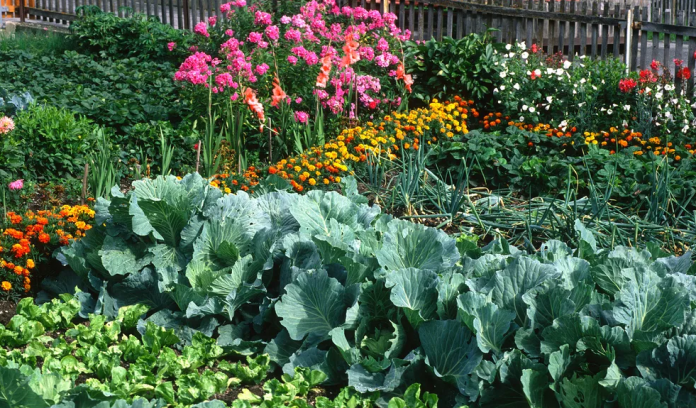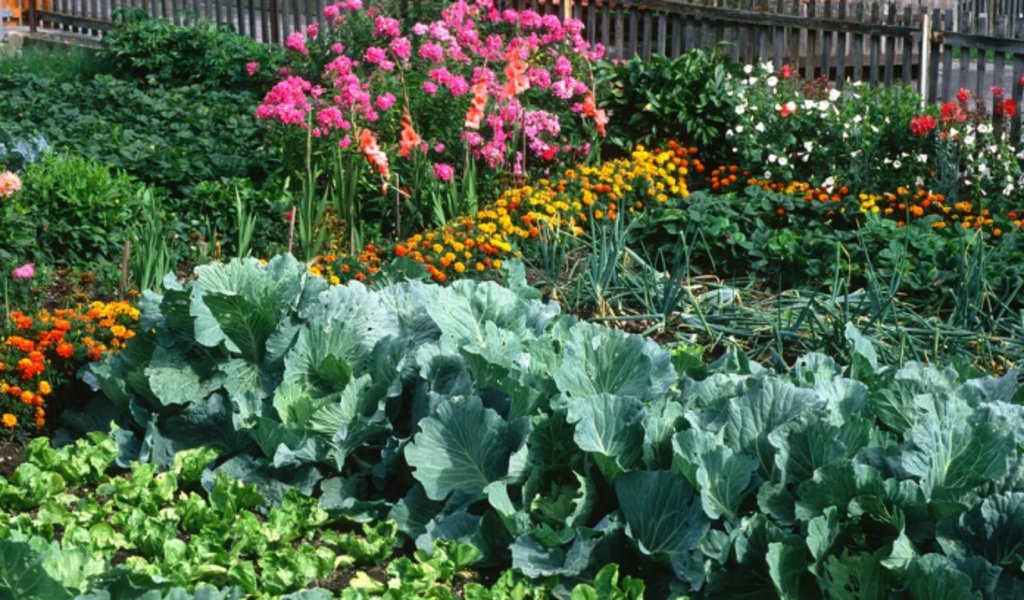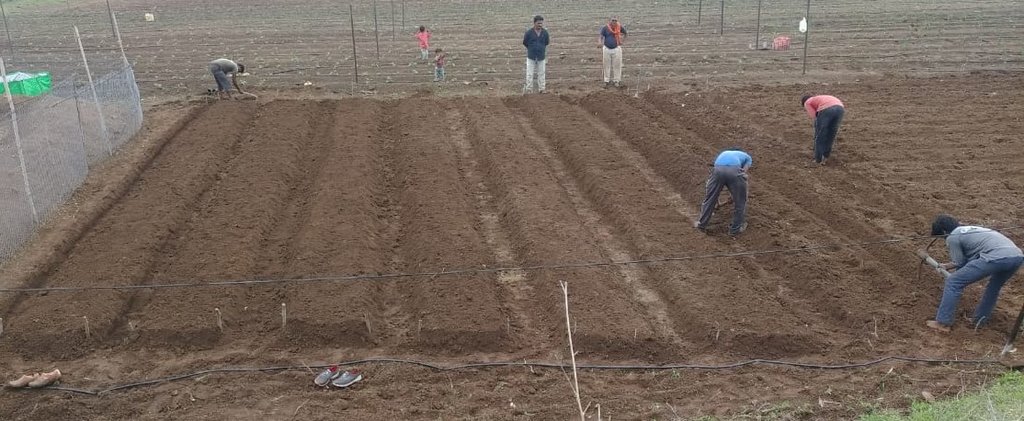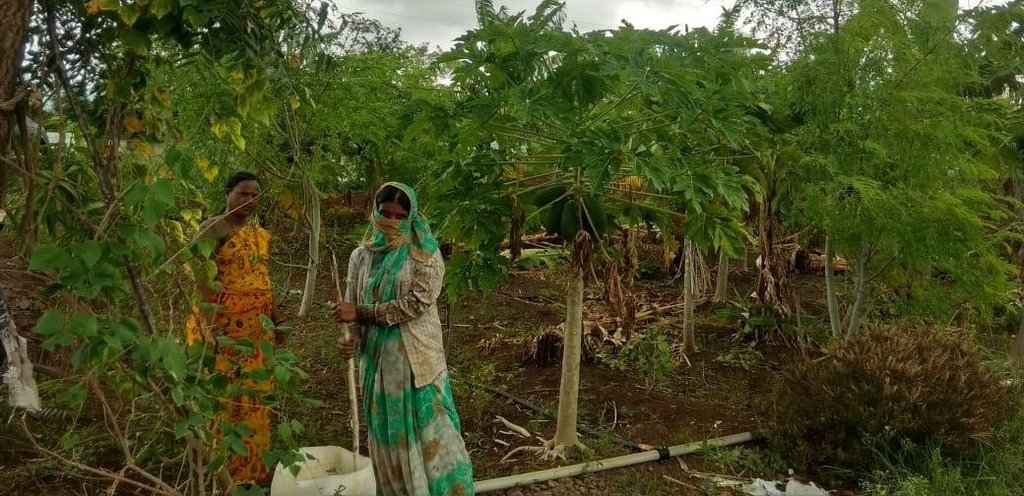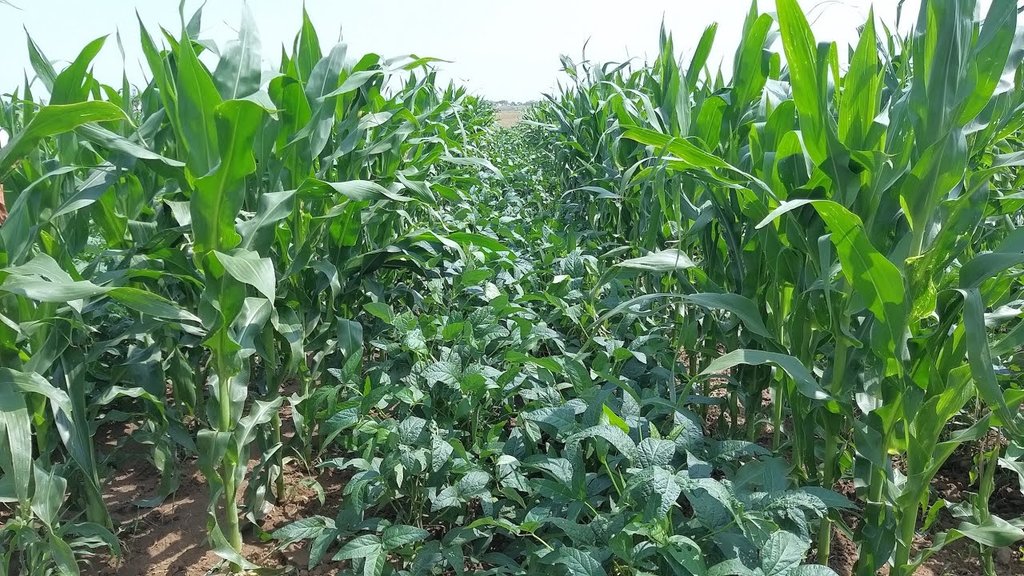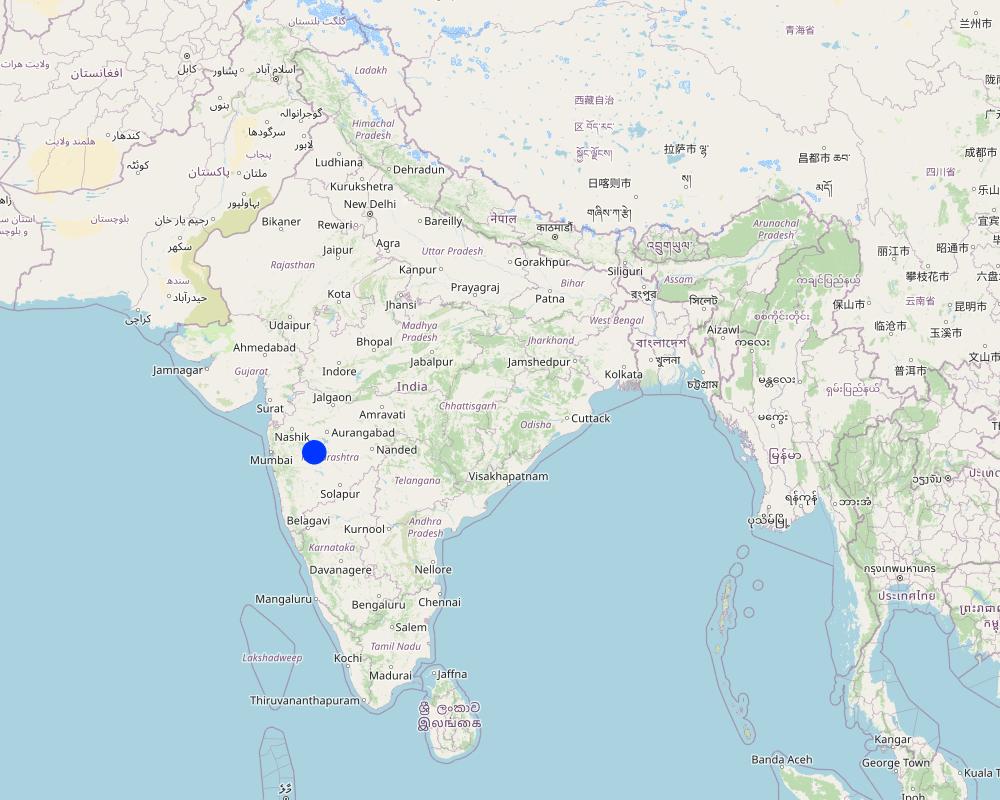Multilayer Farming Systems For Ensuring Food Diversity And Increasing Resilience [ប្រទេសឥណ្ឌា]
- ការបង្កើត៖
- បច្ចុប្បន្នភាព
- អ្នកចងក្រង៖ Santosh Gupta
- អ្នកកែសម្រួល៖ Noel Templer, Stephanie Katsir, Tabitha Nekesa, Ahmadou Gaye, Siagbé Golli
- អ្នកត្រួតពិនិត្យច្រើនទៀត៖ Udo Höggel, Rima Mekdaschi Studer, Sally Bunning
Mishrit kheti
technologies_6724 - ប្រទេសឥណ្ឌា
- សង្ខេបជា PDF
- សេចក្តីសង្ខេបពេញលេញជាទម្រង់ PDF សម្រាប់បោះពុម្ព
- សេចក្តីសង្ខេបពេញលេញទម្រង់អ៊ីនធឺនេត
- សេចក្តីសង្ខេបពេញលេញ (មិនមានទម្រង់ជាក់លាក់)
- Multilayer Farming Systems For Ensuring Food Diversity And Increasing Resilience: 5 ខែ តុលា ឆ្នាំ 2023 (inactive)
- Multilayer Farming Systems For Ensuring Food Diversity And Increasing Resilience: 20 ខែ វិច្ឆិកា ឆ្នាំ 2023 (inactive)
- Multilayer Farming Systems For Ensuring Food Diversity And Increasing Resilience: 17 ខែ មេសា ឆ្នាំ 2024 (public)
ពិនិត្យមើលគ្រប់ផ្នែក
ពង្រីកមើលទាំងអស់ បង្រួមទាំងអស់1. ព័ត៌មានទូទៅ
1.2 ព័ត៌មានលម្អិតពីបុគ្គលសំខាន់ៗ និងស្ថាប័នដែលចូលរួមក្នុងការវាយតម្លៃ និងចងក្រងឯកសារនៃបច្ចេកទេស
ឈ្មោះគម្រោងដែលបានចងក្រងឯកសារ/ វាយតម្លៃលើបច្ចេកទេស (បើទាក់ទង)
Soil protection and rehabilitation for food security (ProSo(i)l)ឈ្មោះអង្គភាពមួយ (ច្រើន) ដែលបានចងក្រងឯកសារ/ វាយតម្លៃបច្ចេកទេស (បើទាក់ទង)
Deutsche Gesellschaft für Internationale Zusammenarbeit (GIZ)ឈ្មោះអង្គភាពមួយ (ច្រើន) ដែលបានចងក្រងឯកសារ/ វាយតម្លៃបច្ចេកទេស (បើទាក់ទង)
CIAT International Center for Tropical Agriculture (CIAT International Center for Tropical Agriculture) - ប្រទេសកេនយ៉ាឈ្មោះអង្គភាពមួយ (ច្រើន) ដែលបានចងក្រងឯកសារ/ វាយតម្លៃបច្ចេកទេស (បើទាក់ទង)
Ecociate Consultants (Ecociate Consultants) - ប្រទេសឥណ្ឌា1.3 លក្ខខណ្ឌទាក់ទងទៅនឹងការប្រើប្រាស់ទិន្នន័យដែលបានចងក្រងតាមរយៈ វ៉ូខេត
អ្នកចងក្រង និង(បុគ្គលសំខាន់ៗ)យល់ព្រមទទួលយកនូវលក្ខខណ្ឌនានាទាក់ទងទៅនឹងការប្រើប្រាស់ទិន្នន័យដែលបានចងក្រងតាមរយៈវ៉ូខេត:
បាទ/ចា៎
1.4 សេចក្តីប្រកាសស្តីពីចីរភាពនៃការពណ៌នាពីបច្ចេកទេស
តើបច្ចេកទេសដែលបានពណ៌នានេះមានបញ្ហាដែលផ្តោតលើការធ្លាក់ចុះគុណភាពដី, បើដូច្នេះវាមិនអាចត្រូវបានប្រកាសថាជាបច្ចេកទេសនៃការគ្រប់គ្រងប្រកបដោយចីរភាពទេ?
ទេ
មតិយោបល់:
Multilayer farming is a farming practice that involves cultivating a mix of vegetables and fruits on a small piece of land. Additionally, by growing a variety of crops together, multilayer farming can increase yields and provide a more diverse range of foods for households.
2. ការពណ៌នាពីបច្ចេកទេស SLM
2.1 ការពណ៌នាដោយសង្ខេបពីបច្ចេកទេស
និយមន័យបច្ចេកទេស:
Multilayer farming, also known as multi-tier farming, is a technique of intercropping crops of different heights, root and shoot patterns, and maturation times in small plots of land. This technique is cost-effective, easily adaptive, and participatory, providing a large number of food groups to farmers to improve their nutritional levels, providing insurance against crop failure, reducing pest and disease incidence, and improving soil properties and soil fertility conditions. Multilayer farming minimizes crop-weed competition, and soil erosion, and optimizes resource utilization resulting in higher returns and better nutritional value. It promotes sustainable agriculture, maintains a balanced diet, increases income per unit area, and reduces the risk of crop failure.
2.2 ការពណ៌នាលម្អិតពីបច្ចេកទេស
ការពណ៌នា:
Multilayer farming is an agricultural model that aims at achieving maximum production per unit area by utilizing water, manure, and land resources to their full potential. This method is based on the synergies between the different crops and plants planted on a given piece of land. This method is cost-effective and yields more benefits than other farming systems. By cultivating four to five crops with the same amount of fertilizer and water required for a single crop, farmers can increase their income, and multiple crops can be harvested yearly using the same piece of land.
Multilayer farming is based on scientific, ecological, and economic principles, promoting crop diversification, maximizing productivity, utilizing resources more efficiently, and promoting intensive input use. Moreover, it ensures the sustainability of farm resources and the environment in the long term.
The multilayer farming system mainly consists of an overstory of trees or shrubs with an understory of economic or forage crops. By incorporating these principles, farmers can achieve greater yields and financial success while promoting environmental sustainability.
As a part of the program's approach, WOTR (Watershed Organisation Trust, the project implementing partner trained women change-makers) to spread awareness among villagers about the importance of nutrition and a healthy diet. Since 2018, the active promotion of multilayer farming to address food and nutrition insecurity in Maharashtra is undertaken. As a result, 1124 plots across 150 villages in Maharashtra have adopted this unique farming method to enhance food and nutrition security.
The multilayer farming system involves several steps to ensure maximum productivity from the available resources.
1.The first step is land preparation, which involves applying 300 kg of cow dung or vermicompost along with one kg of Trichoderma powder per 36 x 36 feet plot. Trichoderma is a bio-fungicide that helps to prevent fungal infections in plants and roots.
2.Next, eight beds of 3 x 36 feet are prepared with 1.5 to 2 feet of space left in between. These beds need to be arranged in the North-South direction to ensure that plants receive adequate sunlight.
3.After preparing the bed, 1-foot deep channels are dug to drain excess water so ensuring that the crops are not waterlogged.
4.Finally, in the middle of each bed, vegetable and fruit crops are planted according to a crop planning chart. By planting a variety of crops in the same plot, the multilayer farming system ensures the effective utilization of resources and provides an even distribution of income and employment throughout the year by producing several off-season crops.
The multilayer farming system has numerous benefits that make it an effective and sustainable farming method. It makes effective use of soil, water, and other resources, reducing waste and increasing productivity. Additionally the system reduces climate-specific damage and enhances soil health, helping to maintain an ecological balance in the environment. The soil covered minimizes water loss due to soil evaporation, generating a higher income per unit area with an even distribution of income and employment throughout the year. The multilayer farming system generates jobs and allows for better utilization of labor while reducing the impacts of climate-specific hazards such as high-intensity rainfall, soil erosion, and landslides. Multilayer farming also utilizes soil moisture at different depths and solar energy at different heights, improving soil characteristics and adding organic matter to the soil. It reduces pests and disease infestation and provides micro-climate conditions which ensure better productivity of crops underneath. Overall, multilayer farming is a sustainable and efficient farming method that not only maximizes productivity but also enhances soil and environmental health while promoting economic and social well-being.
2.3 រូបភាពនៃបច្ចេកទេស
កំណត់សម្គាល់ទូទៅនៃរូបថត/រូភាព:
The images provide a visual representation of the essential steps followed by farmers to establish a successful multilayer farming system. These steps include land preparation, bed preparation, and planting a variety of crops in the same plot. The dates mentioned here are the dates of collection of these photos from the project implementing team as the photos were taken by different team members at different times.
2.5 ប្រទេស/តំបន់/ទីតាំងកន្លែង ដែលបច្ចេកទេសត្រូវបានអនុវត្ត និងបានគ្រប់ដណ្តប់ដោយការវាយតម្លៃនេះ
ប្រទេស:
ប្រទេសឥណ្ឌា
តំបន់/រដ្ឋ/ខេត្ត:
Maharashtra
បញ្ជាក់បន្ថែមពីលក្ខណៈនៃទីតាំង:
Ahmednagar
បញ្ជាក់ពីការសាយភាយនៃបច្ចេកទេស:
- អនុវត្តនៅកន្លែងជាក់លាក់មួយ/ ប្រមូលផ្តុំនៅតំបន់តូចៗ
តើបច្ចេកទេស (មួយ ឬច្រើន) ទាំងនោះស្ថិតនៅក្នុងតំបន់ការពារជាអចិន្ត្រៃយ៍ណាមួយដែរឬទេ?
ទេ
មតិយោបល់:
In Maharastra State, there are different districts where multilayer farming plots are established such as Ahmednagar, Satara, and Dhule
Map
×2.6 កាលបរិច្ឆេទនៃការអនុវត្ត
បង្ហាញឆ្នាំនៃការចុះអនុវត្ត:
2018
2.7 ការណែនាំពីបច្ចេកទេស
សូមបញ្ជាក់តើបច្ចេកទេសត្រូវបានណែនាំឱ្យអនុវត្តដោយរបៀបណា:
- ពេលកំពុងពិសោធន៍
- តាមរយៈគម្រោង / អន្តរាគមន៍ពីខាងក្រៅ
មតិយោបល់ (ប្រភេទនៃគម្រោង ។ល។):
The intervention is a result of experiments and research by WOTR and other agencies at different project locations
3. ចំណាត់ថ្នាក់នៃបច្ចេកទេស SLM
3.1 គោលបំណងចម្បង (១ ឬច្រើន) នៃបច្ចេកទេសនេះ
- ធ្វើឱ្យប្រសើរឡើងនូវផលិតកម្ម
- កាត់បន្ថយ, បង្ការ, ស្តារឡើងវិញនូវការធ្លាក់ចុះគុណភាពដី
- បន្ស៊ាំទៅនឹងការប្រែប្រួលអាកាសធាតុ/គ្រោះមហន្តរាយ និងផលប៉ះពាល់របស់វា
- បង្កើតផលប្រយោជន៍សេដ្ឋកិច្ច
- បង្កើតផលប្រយោជន៍សង្គម
- Ensure nutritional security
3.2 ប្រភេទដីប្រើប្រាស់មួយប្រភេទ (ច្រើនប្រភេទ) ដែលបានអនុវត្តបច្ចេកទេស
ដីប្រើប្រាស់ចម្រុះនៅលើដីតែមួយ:
ទេ

ដីដាំដំណាំ
- ដំណាំប្រចាំឆ្នាំ
ដំណាំប្រចាំឆ្នាំ - បញ្ជាក់ប្រភេទដំណាំ:
- ធញ្ញជាតិ - ស្រូវសាលី (សិសិររដូវរងារ)
- ធញ្ញជាតិ - ពោតសាលី
- Sugarcane, Horticulture crops like Pomegranate, Guava, Mango etc, Onion, pulses
ចំនួនសារដែលដាំដំណាំក្នុងមួយឆ្នាំ:
- 2
សូមបញ្ជាក់:
In places where irrigation source is availbe the growing seasons vary between 2 to 3
តើជាការអនុវត្តន៍ដំណាំចន្លោះ?
បាទ/ចា៎
តើជាការអនុវត្តន៍ដំណាំវិលជុំ?
បាទ/ចា៎
បើបាទ/ច៎ា សូមបញ្ជាក់:
In places where irrigation is available, farmers grow Kharif crops (summer crops) followed by Rabi crops (winter crops).
មតិយោបល់:
The majority of farmers in various regions tend to practice mono-cropping due to rainfall variability and less rainfall in the region. However, in places where an irrigation source is available, farmers tend to grow second crops in the Rabi season or go for horticulture crops such as fruits and vegetables.
3.3 បន្ទាប់ពីអនុវត្តបច្ចេកទេស តើដីប្រើប្រាស់មានការប្រែប្រួលដែររឺទេ?
បន្ទាប់ពីអនុវត្តបច្ចេកទេស តើដីប្រើប្រាស់មានការប្រែប្រួលដែររឺទេ?
- បាទ/ច៎ា (សូមបំពេញសំណួរខាងក្រោមពីស្ថានភាពដីប្រើប្រាស់មុនពេលអនុវត្តបច្ចេកទេស)
ដីប្រើប្រាស់ចម្រុះនៅលើដីតែមួយ:
បាទ/ចា៎
បញ្ជាក់ពីប្រភេទដីច្រើនប្រភេទ (ដីដាំដំណាំ/ដីចិញ្ចឹមសត្វ/ដីព្រៃឈើ):
- កសិរុក្ខកម្ម

ដីដាំដំណាំ
- ដំណាំប្រចាំឆ្នាំ
- ប្រភេទដើមឈើធំៗ និងដើមឈើតូចៗ
- Horticulture Crops
ដំណាំប្រចាំឆ្នាំ - បញ្ជាក់ប្រភេទដំណាំ:
- ដំណាំយកផ្កា
- បន្លែ - ផ្សេងៗ
- drumstick, marigold, radish, dolichos beans, coriander, spinach, fenugreek, dill, okra, brinjal, tomato, red pumpkin, maize, cowpea, castor, ridge gourd
ប្រភេទដើមឈើធំៗ និងដើមឈើតូចៗ - បញ្ជាក់ប្រភេទ:
- ផ្លែស្វាយ/ផ្លែមង្ឃុត/ផ្លែត្របែក
- ផ្លែល្ហុង
- Sapota
តើជាការអនុវត្តន៍ដំណាំចន្លោះ?
បាទ/ចា៎
ប្រសិនបើបាទ/ច៎ា សូមបញ្ជាក់ប្រភេទដំណាំដែលដាំចន្លោះគ្នានោះ:
In multi-cropping systems, fruits and vegetables are planted in a systematically planned manner using crop planning charts. This approach ensures that the growth of plants complements each other, providing adequate nutrition for the family throughout the year.
តើជាការអនុវត្តន៍ដំណាំវិលជុំ?
បាទ/ចា៎
បើបាទ/ច៎ា សូមបញ្ជាក់:
The combination of vegetables is selected based on the suitability to climate conditions as tomatoes are grown during the winter season, beans during the summer seasons etc.
មតិយោបល់:
The land was mostly converted from mono-cropping systems to a multi-cropping system
3.4 ការផ្គត់ផ្គង់ទឹក
ការផ្គត់ផ្គង់ទឹកនៅកន្លែងអនុវត្តបច្ចេកទេស:
- ទឹកភ្លៀង និងប្រព័ន្ធស្រោចស្រព
មតិយោបល់:
Multi-cropping systems involve covering the soil with crops throughout the year, which helps to reduce evaporation losses. In addition, irrigation is provided using drip or sprinkler systems to minimize water losses. This approach not only conserves water but also helps to maintain soil moisture levels, leading to higher yields and improved plant health. By adopting these practices, farmers can improve the sustainability and resilience of their agricultural systems.
3.5 ក្រុម SLM ដែលបច្ចេកទេសស្ថិតនៅក្នុង
- ធ្វើឱ្យប្រសើរឡើងគម្របដី/ ដំណាំគម្របដី
- ការគ្រប់គ្រងប្រព័ន្ធស្រោចស្រព (រួមទាំងការផ្គត់ផ្គង់ទឹក ប្រព័ន្ធបង្ហូរ)
- គេហសួន
3.6 វិធានការ SLM ដែលបញ្ចូលនូវបច្ចេកទេស

វិធានការក្សេត្រសាស្ត្រ
- A1: ដំណាំ/គម្របដី
- A2: សារធាតុសរីរាង្គ/ជីជាតិដី
- A5: ការគ្រប់គ្រងគ្រាប់ពូជ បង្កើនប្រភេទពូជ

វិធានការរុក្ខជាតិ
- V1: ឈើធំៗ និងដើមឈើតូចៗ

វិធានការគ្រប់គ្រង
- M1: ការផ្លាស់ប្តូរប្រភេទដីប្រើប្រាស់
- M4: ការផ្លាស់ប្តូរចម្បងៗក្នុងការកំណត់ ពេលអនុវត្តសកម្មភាព
មតិយោបល់:
1. Effective utilization of natural resources
2. Reduces climate-specific damage & enhances soil health and reduces water loss due to evaporation from the soil
3. The income per unit area increases substantially with this system and multilayer farming ensures the yield of some crops throughout the year
4. Utilizes the soil moisture well at different depths of soil and effectively utilizes solar energy at different heights
5. Improve the soil characteristics and adds organic matter to the soil
6. Provides a partial guarantee against the market glut of a single commodity and the efficient cultivation of a range of products is possible
3.7 កំណត់ប្រភេទនៃការធ្លាក់ចុះគុណភាពដីសំខាន់ៗដែលបច្ចេកទេសនេះបានដោះស្រាយ

ការបាត់បង់រូបសាស្ត្រនៃដី
- Ps: ការស្រុតចុះនូវសារធាតុសរីរាង្គនៃដី ការពន្លិចដី

ការធ្លាក់ចុះជីវសាស្ត្រនៃដី
- Bc: ការថយចុះនូវគម្របរុក្ខជាតិ
- Bq: ការថយចុះនូវជីវម៉ាស/ បរិមាណ
- Bs: សមាសភាពដែលមានគុណភាពនិងប្រភេទសត្វ/ការថយចុះនូវជីវចម្រុះ
- Bp: ការកើនឡើងនូវសត្វល្អិត ឬជំងឺ បាត់បង់នូវសត្វមានប្រយោជន៍
មតិយោបល់:
Multilayer farming covers the soil throughout the year with crops, fruits, and vegetables. The micro-climate enables diversified crops to grow together and provide nutrition to the family through out the year. The year around soil cover reduces soil erosion by wind and flood.
3.8 ការពារ កាត់បន្ថយ ឬស្តារឡើងវិញនៃការធ្លាក់ចុះគុណភាពដី
បញ្ជាក់ពីគោលដៅរបស់បច្ចេកទេស ដែលផ្តោតទៅការធ្លាក់ចុះគុណភាពដី:
- ការការពារការធ្លាក់ចុះគុណភាពដី
- ការកាត់បន្ថយការធ្លាក់ចុះគុណភាពដី
មតិយោបល់:
Multilayer farming improves soil fertility by improving the microbial activities in the soil as the ecosystem of different root zones, plants and organic matter coupled with organic inputs creates a healthy plant environment
4. បច្ចេកទេសជាក់លាក់ សកម្មភាពអនុវត្ត ធាតុចូល និងថ្លៃដើម
4.2 ព័ត៌មានទូទៅដែលពាក់ព័ន្ធនឹងការគណនាធាតុចូល និងថ្លៃដើម
កំណត់របៀបនៃការគណនាថ្លៃដើម និងធាតុចូល:
- ក្នុងតំបន់អនុវត្តបច្ចេកទេស
កំណត់ទំហំ និងឯកត្តាផ្ទៃដី:
1
បើសិនប្រើឯកតាតាមតំបន់ សូមបញ្ជាក់តម្លៃបម្លែងវាទៅជាហិកតា (ឧ. 1 ហិកតា = 2.47 អា)៖ 1 ហិកតា =:
ha
ផ្សេងៗ/ រូបិយប័ណ្ណជាតិ (បញ្ជាក់):
INR
បើពាក់ព័ន្ធសូមកំណត់អត្រាប្តូរប្រាក់ពីដុល្លាទៅរូបិយប័ណ្ណតំបន់ (ឧ. 1 ដុល្លារ = 79.9 រៀលនៃរូបិយប័ណ្ណប្រេស៊ីល) ៖ 1 ដុល្លារ =:
80,0
កំណត់ថ្លៃឈ្នួលជាមធ្យមនៃការជួលកម្លាំងពលកម្មក្នុងមួយថ្ងៃ:
200
4.3 សកម្មភាពបង្កើត
| សកម្មភាព | រយៈពេល (រដូវកាល) | |
|---|---|---|
| 1. | Land Preperation | June |
| 2. | Preperation of beds for seed sowing | June |
| 3. | Sowing of seeds for fruits | Early June |
| 4. | Fencing of the field | Before the sowing |
មតិយោបល់:
Farmers can use local resources such as Bamboo or other crop residues for fencing purposes as well. Land needs to be prepared before the onset of monsoon (during the summer season). Once a multilayer plot is established there is no need to prepare the land as well.
4.4 ថ្លៃដើម និងធាតុចូលដែលត្រូវការសម្រាប់ការបង្កើតបច្ចេកទេស
| បញ្ជាក់ពីធាតុចូល | ឯកតា | បរិមាណ | ថ្លៃដើមក្នុងមួយឯកតា | ថ្លៃធាតុចូលសរុប | % នៃថ្លៃដើមដែលចំណាយដោយអ្នកប្រើប្រាស់ដី | |
|---|---|---|---|---|---|---|
| កម្លាំងពលកម្ម | Land preparation | person days | 2,0 | 200,0 | 400,0 | 100,0 |
| កម្លាំងពលកម្ម | Preperation of beds for sowing | Person days | 3,0 | 200,0 | 600,0 | 100,0 |
| សម្ភារៈ | Fencing material | Lumpsum | 1,0 | 5000,0 | 5000,0 | 100,0 |
| សម្ភារៈដាំដុះ | Seeds for fruit trees (seeds and planting material) | Plant | 100,0 | 50,0 | 5000,0 | 100,0 |
| ជី និងសារធាតុពុល | Fram yard manure | Tons | 10,0 | 600,0 | 6000,0 | 100,0 |
| ផ្សេងៗ | Miscellaneous | 1,0 | 2000,0 | 2000,0 | 100,0 | |
| ថ្លៃដើមសរុបក្នុងការបង្កើតបច្ចេកទេស | 19000,0 | |||||
| ថ្លៃដើមសរុបក្នុងការបង្កើតបច្ចេកទេសគិតជាដុល្លារ | 237,5 | |||||
មតិយោបល់:
Costs towards labour, farm yard manure and sometimes seeds are internally arranged by the land users thus there may not be any cost to pay.
4.5 សកម្មភាពថែទាំ
| សកម្មភាព | ពេលវេលា/ ភាពញឹកញាប់ | |
|---|---|---|
| 1. | Sowing of seeds | June-July/October-November/April/March/April |
| 2. | Application of organic manures | Across the year at critical growth stages |
| 3. | Irrigation | Across the year at critical growth stages |
| 4. | Bio-inputs | Based on the plant needs |
| 5. | Harvesting of leafy vegetables, fruits, fodder and other produces | Multiple plucking during the year |
| 6. | Sales of farm produces | Multiple times during the year |
មតិយោបល់:
Maintenance activities vary farmers to farmers depending upon the kind of fruits and vegetables planted, availability of resources and land area under cultivation
4.6 កំណត់ថ្លៃដើមសម្រាប់ការថែទាំ/ សកម្មភាពរបស់បច្ចេកទេស (ក្នុងរយៈពេលមួយឆ្នាំ)
| បញ្ជាក់ពីធាតុចូល | ឯកតា | បរិមាណ | ថ្លៃដើមក្នុងមួយឯកតា | ថ្លៃធាតុចូលសរុប | % នៃថ្លៃដើមដែលចំណាយដោយអ្នកប្រើប្រាស់ដី | |
|---|---|---|---|---|---|---|
| កម្លាំងពលកម្ម | Sowing of seeds | Person days | 8,0 | 200,0 | 1600,0 | 100,0 |
| កម្លាំងពលកម្ម | Application of FYM and other inputs | Person days | 5,0 | 200,0 | 1000,0 | 100,0 |
| កម្លាំងពលកម្ម | Maintenance and monitoring of the field | Person days | 50,0 | 100,0 | 5000,0 | 100,0 |
| កម្លាំងពលកម្ម | Harvesting | Person days | 20,0 | 200,0 | 4000,0 | 100,0 |
| សម្ភារៈដាំដុះ | Seeds and planting material | Kg | 0,25 | 1000,0 | 250,0 | 100,0 |
| ជី និងសារធាតុពុល | Farm yard manure and other inputs | Tons | 5,0 | 750,0 | 3750,0 | 100,0 |
| ផ្សេងៗ | Other cost | Lumpsum | 1,0 | 1000,0 | 1000,0 | 100,0 |
| ថ្លៃដើមសរុបសម្រាប់ការថែទាំដំណាំតាមបច្ចេកទេស | 16600,0 | |||||
| ថ្លៃដើមសរុបសម្រាប់ការថែទាំដំណាំតាមបច្ចេកទេសគិតជាដុល្លារ | 207,5 | |||||
មតិយោបល់:
These farms are mostly managed by the farmers themselves without hiring any additional labour. Thus, labour cost is not something farmers need to pay for.
4.7 កត្តាសំខាន់បំផុតដែលមានឥទ្ធិពលដល់ការចំណាយ
ពណ៌នាពីកត្តាប៉ះពាល់ចម្បងៗទៅលើថ្លៃដើម:
1. Availability of family labour to manage the field operations
2. Availability of dairy animals at the household level to meet the FYM needs
5. លក្ខណៈបរិស្ថានធម្មជាតិ និងមនុស្ស
5.1 អាកាសធាតុ
បរិមាណទឹកភ្លៀងប្រចាំឆ្នាំ
- < 250 មម
- 251-500 មម
- 501-750 មម
- 751-1,000 មម
- 1,001-1,500 មម
- 1,501-2,000 មម
- 2,001-3,000 មម
- 3,001-4,000 មម
- > 4,000 មម
កំណត់បរិមាណទឹកភ្លៀង (បើដឹង) ជា មីលីម៉ែត្រ:
561,00
លក្ខណៈពិសេស/ មតិយោបល់លើរដូវភ្លៀង:
Deccan Plateau, Hot Semi-Arid Eco-Region as per the ICAR classification of Ecological Zone
បញ្ជាក់ឈ្មោះឯកសារយោងនៃស្ថានីយឧតុនិយម:
https://krishi.icar.gov.in/jspui/bitstream/123456789/30264/1/MH14.pdf
តំបន់កសិអាកាសធាតុ
- មានភ្លៀងតិចតួច
Length of growing period: less than 90 days
Rainy days: 44
5.2 សណ្ឋានដី
ជម្រាលជាមធ្យម:
- រាបស្មើ (0-2%)
- ជម្រាលតិចតួច (3-5%)
- មធ្យម (6-10%)
- ជម្រាលខ្ពស់បន្តិច (11-15%)
- ទីទួល (16-30%)
- ទីទួលចោត (31-60%)
- ទីទួលចោតខ្លាំង (>60%)
ទម្រង់ដី:
- ខ្ពង់រាប
- កំពូលភ្នំ
- ជម្រាលភ្នំ
- ជម្រាលទួល
- ជម្រាលជើងភ្នំ
- បាតជ្រលងភ្នំ
តំបន់តាមរយៈកម្ពស់ :
- 0-100 ម
- 101-500 ម
- 501-1,000 ម
- 1,001-1,500 ម
- 1,501-2,000 ម
- 2,001-2,500 ម
- 2,501-3,000 ម
- 3,001-4,000 ម
- > 4,000 ម
បញ្ជាក់ថាតើបច្ចេកទេសនេះត្រូវបានអនុវត្តន៍នៅក្នុង:
- មិនពាក់ព័ន្ធទាំងអស់
មតិយោបល់ និងបញ្ចាក់បន្ថែមអំពីសណ្ឋានដី :
Physiographically the district can be broadly divided in four major characteristic landforms viz., hill and ghat section (7.6% area); foothill zone (19.4% area); plateau (3.71% area) and plains (occupy 69.30% area). The intervention has been implemented in different villages of the district.
5.3 ដី
ជម្រៅដីជាមធ្យម:
- រាក់ខ្លាំង (0-20 សម)
- រាក់ (21-50 សម)
- មធ្យម (51-80 សម)
- ជ្រៅ (81-120 សម)
- ជ្រៅខ្លាំង (> 120 សម)
វាយនភាពដី (ស្រទាប់លើ):
- ម៉ត់/ ធ្ងន់ (ឥដ្ឋ)
វាយនភាពដី (> 20 សម ស្រទាប់ក្នុង):
- ម៉ត់/ ធ្ងន់ (ឥដ្ឋ)
សារធាតុសរីរាង្គនៅស្រទាប់ដីខាងលើ:
- ទាប (<1%)
បើអាចសូមភ្ជាប់ការពណ៌នាពីដីឱ្យបានច្បាស់ ឬព័ត៌មានដែលអាចទទួលបាន ឧ. ប្រភេទដី, pH ដី/ ជាតិអាស៊ីត, សមត្ថភាពផ្លាស់ប្តូរកាចុង, វត្តមាននីត្រូសែន, ភាពប្រៃ ។ល។:
The soil types of the district are broadly divided into four categories namely coarse shallow soil; medium black soil; deep black soil and reddish soil occupying about 38, 41, 13 and 8 percent of the cultivated area respectively. In the first two categories, soil moisture is the predominant limiting factor affecting productivity of crops particularly under rainfed condition. (source-http://www.kvk.pravara.com/pages/District%20Profile/District%20Profile.htm)
5.4 ទឹកដែលអាចទាញមកប្រើប្រាស់បាន និងគុណភាពទឹក
នីវ៉ូទឹកក្រោមដី:
> 50 ម
គុណភាពទឹក (មិនបានធ្វើប្រត្តិកម្ម):
ទឹកពិសារដែលមានគុណភាពល្អ
គុណភាពទឹក គឺផ្តោតទៅលើ៖:
ទាំងទឹកក្រោមដី និងលើផ្ទៃដី
តើមានបញ្ហាភាពទឹកប្រៃហូរចូលមកដែរឬទេ?
ទេ
តើទឹកជំនន់កំពុងកើតមាននៅតំបន់នេះដែររឺទេ?
ទេ
មតិយោបល់ និងលក្ខណៈពិសេសផ្សេងៗទៀតលើគុណភាព និងបរិមាណទឹក :
On an average 26.3 per cent of the cultivated area is under irrigation, out of which 71.5 per cent is under well irrigation (including lift irrigation) and remaining area is under canal irrigation. (http://www.kvk.pravara.com/pages/District%20Profile/District%20Profile.htm)
The overall stage of ground water development for the district is quite high i.e., 79.8%. Further ground water development is not recommended without adhering to the precautionary measures i.e., artificial recharge to augment the ground water resources and adoption of ground water management practices. Ground water quality in the wells
monitored by the concerned authorities in the district is affected because of high NO3 concentrations. (http://cgwb.gov.in/District_Profile/Maharashtra/Ahmadnagar.pdf)
5.5 ជីវៈចម្រុះ
ភាពសម្បូរបែបនៃប្រភេទ:
- ទាប
ភាពសម្បូរបែបនៃទីជម្រក:
- ទាប
មតិយោបល់ និងលក្ខណៈពិសេសផ្សេងទៀតលើជីវចម្រុះ:
The majority of the area is under farming. Mono cropping is the generally practiced by farmers.
5.6 លក្ខណៈនៃអ្នកប្រើប្រាស់ដីដែលអនុវត្តបច្ចេកទេស
នៅមួយកន្លែង ឬពនេចរ :
- នៅមួយកន្លែង
ទីផ្សារនៃប្រព័ន្ធផលិតកម្ម:
- ពាក់កណ្តាលពាណិជ្ជកម្ម (ផ្គត់ផ្គង់ខ្លួនឯង/ ពាណិជ្ជកម្ម)
ចំណូលក្រៅកសិកម្ម:
- 10-50% នៃចំណូល
កម្រិតជីវភាព:
- មិនល្អ
- មធ្យម
ឯកជន ឬក្រុម:
- ធ្វើខ្លួនឯង/ គ្រួសារ
- ជាក្រុម/ សហគមន៍
កម្រិតប្រើប្រាស់គ្រឿងយន្ត:
- ប្រើកម្លាំងពលកម្ម
- គ្រឿងយន្ត/ ម៉ាស៊ីន
យេនឌ័រ:
- ស្ត្រី
- បុរស
អាយុរបស់អ្នកប្រើប្រាស់ដី:
- យុវវ័យ
- វ័យកណ្តាល
សូមបញ្ជាក់ពីលក្ខណៈពាក់ព័ន្ធផ្សេងទៀតអំពីអ្នកប្រើប្រាស់ដី:
Most land users covered during the project are small and marginal farmers with land up to 2 ha. The focus has been on women farmers to ensure the self-consumption of diverse food groups harvested from the multi-layer plots. The land users belong to a heterogeneous group of individuals coming from different social backgrounds and caste segments.
5.7 ទំហំផ្ទៃដីជាមធ្យមនៃដីប្រើប្រាស់ដោយអ្នកប្រើប្រាស់ដី ក្នុងការអនុវត្តបច្ចេកទេស
- < 0.5 ហិកតា
- 0.5-1 ហិកតា
- 1-2 ហិកតា
- 2-5 ហិកតា
- 5-15 ហិកតា
- 15-50 ហិកតា
- 50-100 ហិកតា
- 100-500 ហិកតា
- 500-1,000 ហិកតា
- 1,000-10,000 ហិកតា
- > 10,000 ហិកតា
តើផ្ទៃដីនេះចាត់ទុកជាទំហំកម្រិតណាដែរ ខ្នាតតូច មធ្យម ឬខ្នាតធំ (ធៀបនឹងបរិបទតំបន់)?
- ខ្នាតតូច
មតិយោបល់:
Nearly 61% of farmers fall into the category of landholding less than 1 hectare. (https://mahades.maharashtra.gov.in/files/publication/dsa_ahmednagar_2014.pdf)
5.8 ភាពជាម្ចាស់ដី កម្មសិទ្ធប្រើប្រាស់ដី និងកម្មសិទ្ធប្រើប្រាស់ទឹក
ភាពជាម្ចាស់ដី:
- ឯកជន មានកម្មសិទ្ធ
កម្មសិទ្ធិប្រើប្រាស់ដី:
- ឯកជន
កម្មសិទ្ធប្រើប្រាស់ទឹក:
- អាស្រ័យផលសេរី (មិនមានការកំណត់)
តើកម្មសិទ្ធប្រើប្រាស់ដី គឺផ្អែកលើប្រព័ន្ធច្បាប់បែបបុរាណ?
ទេ
5.9 ការប្រើប្រាស់សេវាកម្ម និងហេដ្ឋារចនាសម្ព័ន្ធ
សុខភាព:
- មិនល្អ
- មធ្យម
- ល្អ
ការអប់រំ:
- មិនល្អ
- មធ្យម
- ល្អ
ជំនួយបច្ចេកទេស:
- មិនល្អ
- មធ្យម
- ល្អ
ការងារ (ឧ. ការងារក្រៅកសិដ្ឋាន):
- មិនល្អ
- មធ្យម
- ល្អ
ទីផ្សារ:
- មិនល្អ
- មធ្យម
- ល្អ
ថាមពល:
- មិនល្អ
- មធ្យម
- ល្អ
ផ្លូវ និងការដឹកជញ្ជូន:
- មិនល្អ
- មធ្យម
- ល្អ
ទឹកផឹក និងអនាម័យ:
- មិនល្អ
- មធ្យម
- ល្អ
សេវាកម្មហិរញ្ញវត្ថុ:
- មិនល្អ
- មធ្យម
- ល្អ
មតិយោបល់:
The district is one among the progressive districts of Maharashtra and is well connected with a good network of roads and railways.
6. ផលប៉ះពាល់ និងការសន្និដ្ឋាន
6.1 ផលប៉ះពាល់ក្នុងបរិវេណអនុវត្តបច្ចេកទេសដែលកើតមាន
ផលប៉ះពាល់លើសេដ្ឋកិច្ចសង្គម
ផលិតផល
ផលិតកម្មដំណាំ
មតិយោបល់/ ការបញ្ជាក់:
Round the year farm, produce of vegetables and fruits is available from multilayer fields. The data is based on the observation of land users, there has not been any study to assess possible qualitative improvements
ភាពសម្បូរបែបនៃផលិតផល
មតិយោបល់/ ការបញ្ជាក់:
Farmers grow multilayer crops in smaller land sizes thus increasing the diversity of the products and the nutrition quality at the household level
ផ្ទៃដីផលិតកម្ម
មតិយោបល់/ ការបញ្ជាក់:
Efficient use of land by growing Multilayer Farming led to efficient utilization of the small farm plots
ទឹកដែលអាចទាញមកប្រើប្រាស់បាន និងគុណភាពទឹក
ទឹកប្រើប្រាស់សម្រាប់ស្រោចស្រព
មតិយោបល់/ ការបញ្ជាក់:
The use of micro irrigation led to a more efficient use of the same quantity of water allowing for the irrigation of land for a longer duration
ចំណូល និងថ្លៃដើម
ការចំណាយលើធាតុចូលកសិកម្ម
មតិយោបល់/ ការបញ្ជាក់:
Organic inputs such as cow dung, cow urine, etc were used. This reduced the cost of the inputs.
ចំណូលក្នុងកសិដ្ឋាន
មតិយោបល់/ ការបញ្ជាក់:
Income from farms increased as farm yields increased. Excess produce of vegetables and fruits is sold in the market.
ភាពសម្បូរបែបប្រភពប្រាក់ចំណូល
មតិយោបល់/ ការបញ្ជាក់:
As the farmers shift from mono-crop to multilayer cropping. This reduces the risk of crop failure faced by mono-crop farmers.
ផលប៉ះពាល់ទៅលើសេដ្ឋកិច្ចសង្គមផ្សេងៗ
Intake of Nutritional Food
មតិយោបល់/ ការបញ្ជាក់:
Intake of nutritional food increased as the availability of fruits and vegetables no longer depended exclusively on markets
ផលប៉ះពាល់ទៅលើវប្បធម៌សង្គម
សន្តិសុខស្បៀង/ ភាពគ្រប់គ្រាន់ខ្លួនឯង
ស្ថានភាពសុខភាព
មតិយោបល់/ ការបញ្ជាក់:
Nutritional food available for consumption
ផលប៉ះពាល់ទៅលើអេកូឡូស៊ី
វដ្តទឹក/លំហូរ
រំហួត
មតិយោបល់/ ការបញ្ជាក់:
Crop cover for a longer duration over the soil, reducing evaporation losses
ដី
សំណើមដី
មតិយោបល់/ ការបញ្ជាក់:
Use of organic practices and covering the soil with crop and dry crop litter for a longer duration increased the soil moisture retention capacity
គម្របដី
សារធាតុសរីរាង្គដី/ការបូនក្រោមដី
មតិយោបល់/ ការបញ្ជាក់:
Bio-inputs and dry crop litter added to the soil increased the soil organic matter
ជីវចម្រុះ៖ ដំណាំ, សត្វ
ជីវម៉ាស/ កាបូនលើដី
ភាពសម្បូរបែបនៃរុក្ខជាតិ
មតិយោបល់/ ការបញ្ជាក់:
Crop diversity: vegetables and fruit crops are grown
ការគ្រប់គ្រងកត្តាចង្រៃ/ ជំងឺ
មតិយោបល់/ ការបញ្ជាក់:
As multiple crops are grown, pest and disease infestation is reduced
បញ្ជាក់ពីការប៉ាន់ស្មាននៃផលប៉ះពាល់ក្នុងបរិវេណអនុវត្តបច្ចេកទេស (វាស់វែង):
The impact areas indicated in the document are based on the experience and observations of the land users and field-level workers of implementing agencies. There has not been any scientific study to measure the quantitative impact of the intervention.
6.3 ភាពប្រឈម និងភាពរួសនៃបច្ចេកទេសទៅនឹងការប្រែប្រួលអាកាសធាតុ និងគ្រោះអាកាសធាតុ/ គ្រោះមហន្តរាយ (ដែលដឹងដោយអ្នកប្រើប្រាស់ដី)
មតិយោបល់:
The micro-climate of the multilayered farm is maintained, enabling the crops to grow well
6.4 ការវិភាគថ្លៃដើម និងអត្ថប្រយោជន៍
តើផលចំណេញ និងថ្លៃដើមត្រូវបានប្រៀបធៀបគ្នាយ៉ាងដូចម្តេច (ទស្សនៈរបស់អ្នកប្រើប្រាស់ដី)?
រយៈពេលខ្លី:
វិជ្ជមាន
រយៈពេលវែង:
វិជ្ជមាន
តើផលចំណេញ និងការថែទាំ/ ជួសជុលត្រូវបានប្រៀបធៀបគ្នាយ៉ាងដូចម្តេច (ទស្សនៈរបស់អ្នកប្រើប្រាស់ដី)?
រយៈពេលខ្លី:
វិជ្ជមាន
រយៈពេលវែង:
វិជ្ជមាន
6.5 ការទទួលយកបច្ចេកទេស
- 1-10%
ក្នុងចំណោមគ្រួសារទាំងអស់ដែលបានអនុវត្តបច្ចេកទេស តើមានប៉ុន្មានគ្រួសារដែលចង់ធ្វើដោយខ្លួនឯង ដោយមិនទទួលបានសម្ភារៈលើកទឹកចិត្ត/ប្រាក់ឧបត្ថម្ភ?:
- 91-100%
6.6 ការបន្សុំា
តើថ្មីៗនេះ បច្ចេកទេសនេះត្រូវបានកែតម្រូវដើម្បីបន្ស៊ាំទៅនឹងស្ថានភាពប្រែប្រួលដែរឬទេ?
បាទ/ចា៎
បើឆ្លើយបាទ/ ចា៎ សូមកំណត់ថាតើស្ថានភាពប្រែប្រួលមួយណាត្រូវបានបន្ស៊ាំ:
- បម្រែបម្រួលទីផ្សារ
បញ្ជាក់ពីការបន្ស៊ាំនៃបច្ចេកទេស (ការរៀបចំ, ឧបករណ៍/ប្រភេទ ។ល។):
The Vegetable and fruits crops are modified based on the Household requirement
6.7 ភាពខ្លាំង/ គុណសម្បត្តិ/ ឱកាសនៃបច្ចេកទេស
| ភាពខ្លាំង/ គុណសម្បត្តិ/ ឱកាសនៅកន្លែងរបស់អ្នកប្រើប្រាស់ដី |
|---|
| Diversified vegetables and fruits available for household consumption |
| Increase in household income, as the excess produce is sold in the market and also reduced dependency on markets to purchase fruits and vegetables |
| Small farm plot (1300 sq. ft) is utilized under multilayer farming, remaining farmland is available for cereal, etc |
| ភាពខ្លាំង/ គុណសម្បត្តិ/ ឱកាស ទស្សនៈរបស់បុគ្គលសំខាន់ៗ |
|---|
| Water use efficiency because of the use of micro irrigation and reduction of evaporation as the crops and dry matter cover the soil |
| A good micro-climate of the multilayer farm plot is maintained |
| Availability of a good range of food groups to farmers may lead to improvement in nutritional parameters especially for women and children |
| Improved soil health due to mixed cropping system and enhancement soil microbial activities |
6.8 ភាពខ្សោយ/ គុណវិបត្តិ/ ហានិភ័យនៃបច្ចេកទេស និងវិធីសាស្ត្រដោះស្រាយ
| ភាពខ្សោយ/ គុណវិបត្តិ/ ហានិភ័យ ទស្សនៈរបស់អ្នកប្រើប្រាស់ដី | តើបច្ចេកទេសទាំងនោះបានដោះស្រាយបញ្ហាដូចម្តេច? |
|---|---|
| Labor engagement throughout the year | Mechanization suitable for small farm plots |
| Availability of farm yard manure to ensure cultivation following natural farming practices | Promotion of animal husbandry (dairy) in convergence with the government departments |
| ភាពខ្សោយ/ គុណវិបត្តិ/ ហានិភ័យ ទស្សនៈរបស់អ្នកចងក្រងឬបុគ្គលសំខាន់ៗ | តើបច្ចេកទេសទាំងនោះបានដោះស្រាយបញ្ហាដូចម្តេច? |
|---|---|
| The produce from multilayer farming is diversified and comes in small quantities. Therefore the selling of these small quantities of produce is done in the local market. | Creation of farmers' collectives for selling larger amounts of produce in the market |
| Availability of irrigation is important to ensure the sustainability of intervention | Some water based enterprises can be developed to support the farmers not have irrigation facilities |
7. ឯកសារយោង និងវេបសាយ
7.1 វិធីសាស្ត្រ/ ប្រភពនៃព័ត៌មាន
- ការសម្ភាសន៍ជាមួយអ្នកប្រើប្រាស់ដី
5
- ការចងក្រងពីរបាកការណ៍ និងឯកសារផ្សេងៗទៀតដែលមាន
4
តើពេលណាដែលទិន្នន័យបានចងក្រង (នៅទីវាល)?
09/04/2023
7.3 ការភ្ជាប់ទៅកាន់ព័ត៌មានពាក់ព័ន្ធលើប្រព័ន្ធអនឡាញ
ចំណងជើង/ ពណ៌នា:
How is multilayer farming done?
វេបសាយ:
https://wotr.org/2020/07/18/how-multilayer-farming-is-done/
ចំណងជើង/ ពណ៌នា:
Enhancing Household Food and Nutrition Security With Multilayer Farming
វេបសាយ:
https://www.csrmandate.org/enhancing-household-food-and-nutrition-security-with-multilayer-farming/
ចំណងជើង/ ពណ៌នា:
Kitchen Garden, Multilayer Farming Boost Food Security in Maharashtra
វេបសាយ:
https://wotr.org/2020/05/07/kitchen-garden-multilayer-farming-boost-food-security-in-maharashtra-2/
ការតភ្ជាប់ និងម៉ូឌុល
ពង្រីកមើលទាំងអស់ បង្រួមទាំងអស់ការតភ្ជាប់
គ្មានការតភ្ជាប់
ម៉ូឌុល
គ្មានម៉ូឌុល


